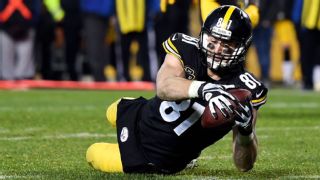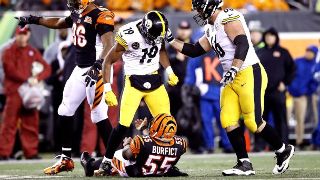|
The games are over. The Eagles have paraded through Philadelphia. Quarterback movement already has begun. The NFL is in full offseason mode, a time that can challenge the most dramatic parts of the regular season for news and pace. While teams prepare for roster overhauls of varying degrees, let's check in on what big-picture things league executives will -- and/or should -- be paying attention to over the next six months leading into 2018 training camps.
Enhance concussion policyThis must be an annual task for the NFL as technology improves and scrutiny increases. There is no more existential threat to the league than brain health. Reported concussions rose to their highest total (281) since the NFL began releasing data in 2012. Most of the rise was attributed to a spike during training camp practices. League executives, led by chief medical officer Dr. Allen Sills and executive vice president of health and safety initiatives Jeffrey Miller, will individually advise teams on strategies to lower that training camp number.
The league already made material policy changes to its game-day protocol in late December, adding a third independent neurologist to the stadium site and a fourth watching from a centralized position in New York City. The league said it conducted more than 600 concussion tests during preseason and regular-season games. But after three high-profile reviews, and several noteworthy instances of players diagnosed after the end of games, the league probably will consider other adjustments as well. Among them: Should players who pass an initial concussion test be subject to a waiting period to guard against delayed onset?
Unify the anthem experienceThe league needs an unambiguous policy for all team personnel during the national anthem, as the current guidelines only say players "should" stand. It's not mandatory, and a protest carries no required discipline. A new approach could take one of three forms: (A) The NFL could voice a clear support for players making social and political statements during the anthem; (B) it could expressly prohibit all anthem demonstrations and require a strict stand-at-attention; or (C) it could scrap the platform altogether and keep teams in the locker room until after the anthem is played. Some owners were angry that commissioner Roger Goodell didn't squash the 2017 protests, but many were upset that the league was caught flat-footed a year after Colin Kaepernick began the initial movement. Owners want the uncertainty resolved, one way or another. And the third option is probably the most painless.
 Don't make catch rule worseGoodell's repeated comments on the catch rule make it clear he has made it an offseason priority. That's the easy part. Who doesn't want to eliminate the mind-numbing analysis of whether a receiver gained and maintained control "throughout the process of the catch"? Goodell wants to rewrite the rule from scratch, but smart people who have spent years studying it have encountered new -- and perhaps equally exasperating -- consequences in every proposal. Would some incompletions turn into fumbles? Would officials struggle to judge possession without the "bright line" of the current rule? Calls to return to what the NFL "used to do" ignore the fundamental change prompted by HD television and replay technology. An HD view of a 1980s game would reveal more (previously unnoticed) shaky catch calls than fans realize. The current rule leads to a handful of head-scratchers in return for a vast majority of clarity. A perfect change -- one that purges controversy while preserving simplicity -- might not exist. The NFL could be left to decide whether to exchange one set of shortcomings for another. Breaking even might be the best it can do.
Re-standardize replayInconsistency in replay was one of the NFL's biggest stories last season, the result of an unexpected transition at the top of the officiating department just as replay decisions were centralized in the league office. It took a while before new senior vice president of officiating Al Riveron, and replay vice president Russell Yurk, found their way to the NFL's "clear and obvious" standard for reversals. Replay is good for the NFL when used in the appropriate context -- i.e., correcting obvious mistakes -- but will ultimately be drummed out if it's used to re-officiate close plays on a frame-by-frame basis. The decision to uphold a touchdown by Philadelphia Eagles tailback Corey Clement in the Super Bowl, on a play in which the ball moved as he tried to get his feet in bounds, suggested Riveron and Yurk are in a better place. But earlier discrepancies must be ironed out permanently over the offseason.
Get the (ownership) house in orderIt was only three months ago that the NFL's most powerful owner was openly pressuring his partners to reject Goodell's contract extension. In the process, the Dallas Cowboys' Jerry Jones revealed he harbors some of the same criticisms Goodell has absorbed from outside the league. The league has survived ownership discord throughout its history, and this episode will prove no different. But some of Jones' complaints -- inefficient staffing in the league office, a failure of proactive leadership and ineffective crisis management -- have registered. Some within the league expect structural changes, and it's worth noting that there already have been a handful of departures from the league office via buyouts and resignations. Goodell isn't going anywhere. Neither is Jones. But the seeds of their clash will cascade through the offseason.
Smooth (and lucrative) transition for the PanthersThe Carolina Panthers are for sale -- a long-anticipated decision that was accelerated by allegations of workplace misconduct by owner Jerry Richardson.
The looming transaction comes at a fascinating time for the NFL. To this point, evidence of rising revenues has muted narratives about diminishing interest in the game and league. (Most recently, owners coaxed a $660 million annual expenditure from Fox to broadcast Thursday Night Football.) The Panthers are likely to be sold for a record price, eclipsing the $1.4 billion Terry and Kim Pegula paid for the Buffalo Bills in 2014. Many around the league will be watching. Nearly half of its primary owners are older than 70. Seven are at least 80, including Richardson. Some owners plan to pass a franchise to their heirs, but others could be motivated to sell based on the Panthers' price.
Assess roots of viewer/audience dataNFL broadcast ratings fell 9.7 percent in the regular season, just a year after falling 8 percent. The audience for a dramatic Super Bowl, one played by two large-market teams, was the smallest in nine years. There was no presidential election to blame for luring viewers in 2017. Already, the NFL has attempted to accelerate the pace of game to produce a crisper broadcast. Meanwhile, a recent Wall Street Journal/NBC News poll suggested fan deterioration among important demographics. Those numbers could be overlaid with a drop in high school football participation -- 4.5 percent since 2010, according to the National Federation of High School Sports -- to form an existential trend. In other words, the decline in key data points can't be considered a blip. It's true the NFL remains television's ratings leader, but its dominance is of a shrinking pie. If they haven't already, owners must make a frank assessment of not just their product, but why its consumption trends have slowed.
Turbocharge global presenceThe upside of domestic stagnation is that about 95 percent of the world's population lives beyond United States borders. There are plenty of new customers available. In the past decade, the NFL has taken moderate steps to establish a foothold in the United Kingdom and, more recently, in Mexico. The gaping hole, however, is Asia -- particularly, China. The NFL has mused vaguely about playing a regular-season game there, but nothing is imminent. One path is to encourage more players to make offseason visits, as Tom Brady and Russell Wilson did in 2017, to promote the game (and their brands) abroad. That's how the NBA expanded its popularity across Asia over the past two decades, starting with Kobe Bryant's first trip in 1998. Whether the NFL is actually facing an existential crisis, its global outreach has never seemed more important.
 Consider a targeting ruleNFL executive vice president Troy Vincent went on record in December saying "we have to consider" a targeting rule, in response to a particularly violent game between the Pittsburgh Steelers and Cincinnati Bengals in Week 13. In essence, the rule would call for a mandatory ejection of a player who hits a defenseless receiver in the head or neck area. At the college level, an instance occurring in the second half of a game mandates suspension for the first half of the following contest. The rule has had mixed success for the NCAA, and to be fair, the primary function of the rule might be to assert a commitment to minimizing dangerous plays. But in the NFL, it also would clarify and elevate the consequences for players, who are subject to ejection by rarely used official discretion but usually are penalized 15 yards. If anything, the league's concussion protocol could have increased incentive to take head shots, because of the greater chance that it would knock a player out for the game at minimal cost to the opposition. But it wouldn't work if not subject to replay; current rules do not make hits to the head reviewable. And the prospects of additional ejections would have to be weighed in the context of a 2017 season that produced 18 disqualifications for various other reasons, believed to be an NFL record. At the very least, targeting will be the subject of intense debate this winter and spring.
Rethink Rooney RuleThe Oakland Raiders' virtual snub of the rule brings an old question into new light: How militant does the NFL want to be on imposing a genuinely diverse search process for its teams? Raiders owner Mark Davis, by his own admission, had been honed in on hiring on Jon Gruden for years. That made two minority candidates a backup plan at best, and a prop at worst. Were their interview experiences alone, cursory as they were, enough to say that the Rooney Rule had served a purpose? Will the NFL ever be able to prevent similar situations? Should it? In scenarios in which owners have pre-chosen candidates -- yes, it happens and will continue to -- is there a way to further the cause of diversity without forcing meaningless interviews? These are questions that at least some in the NFL will address this offseason.
|

